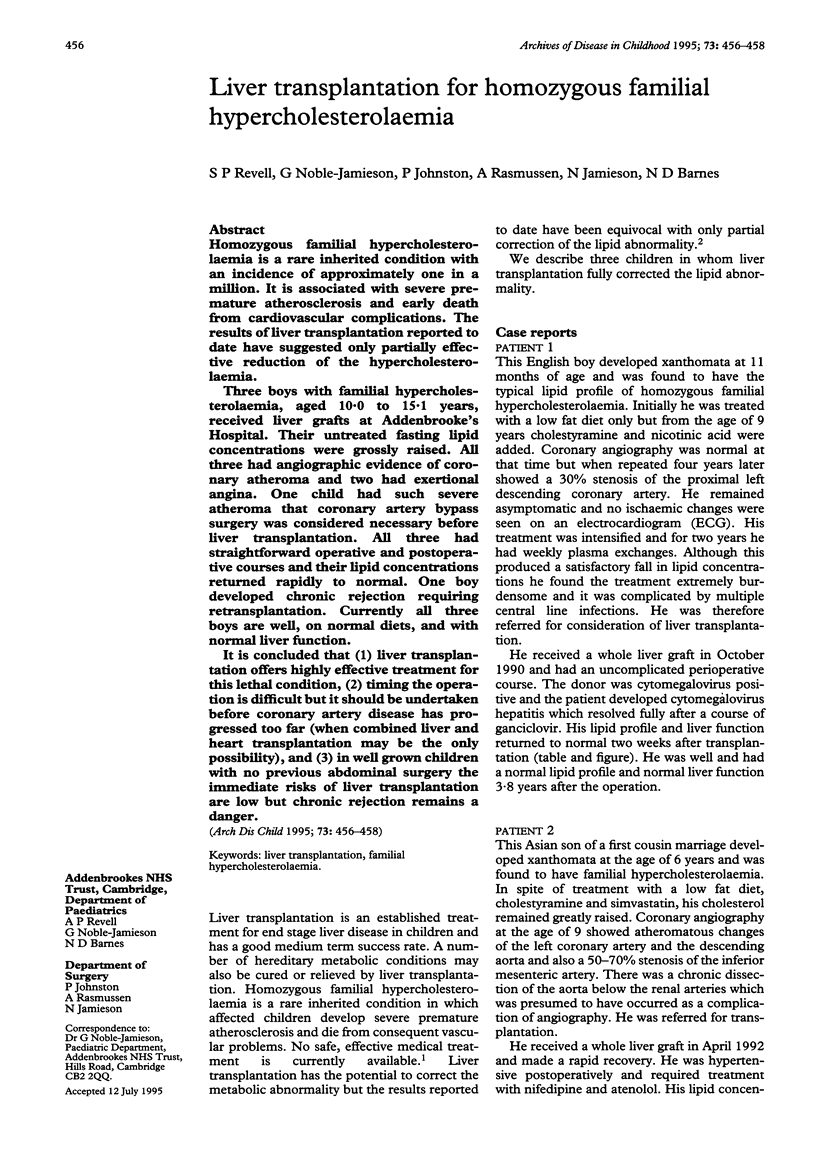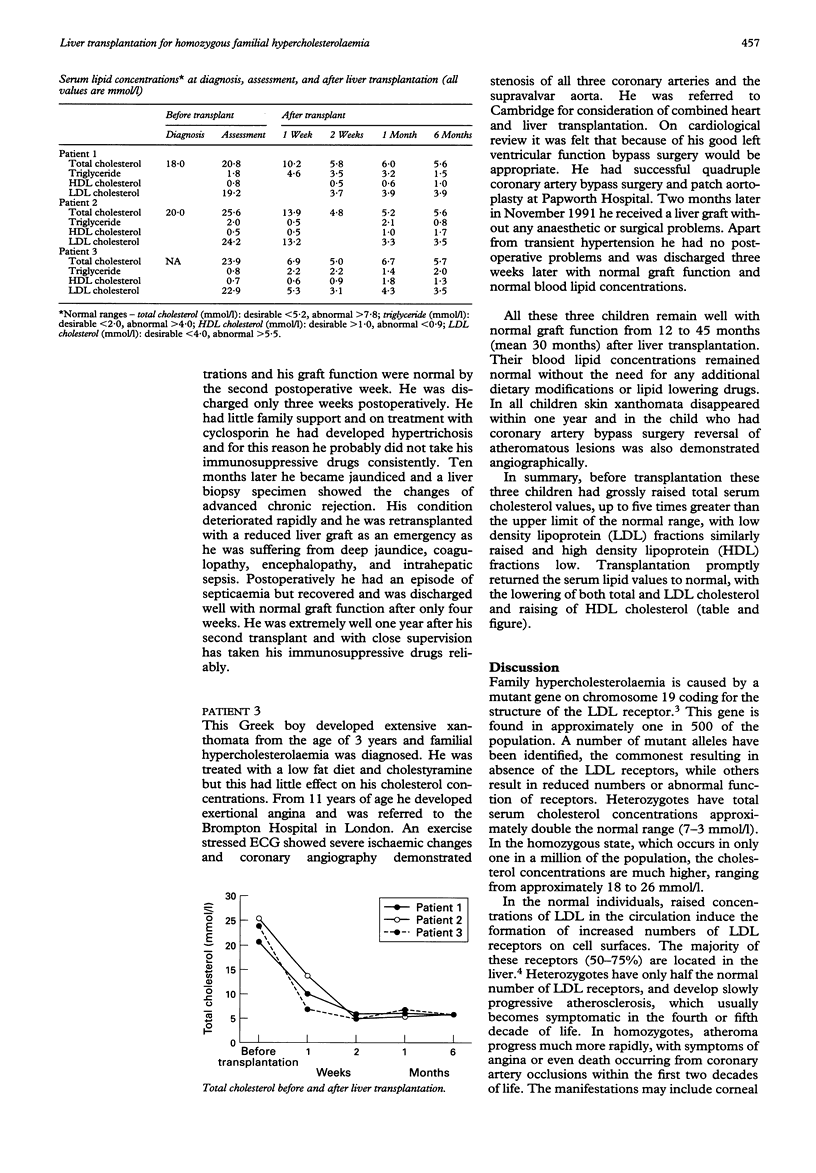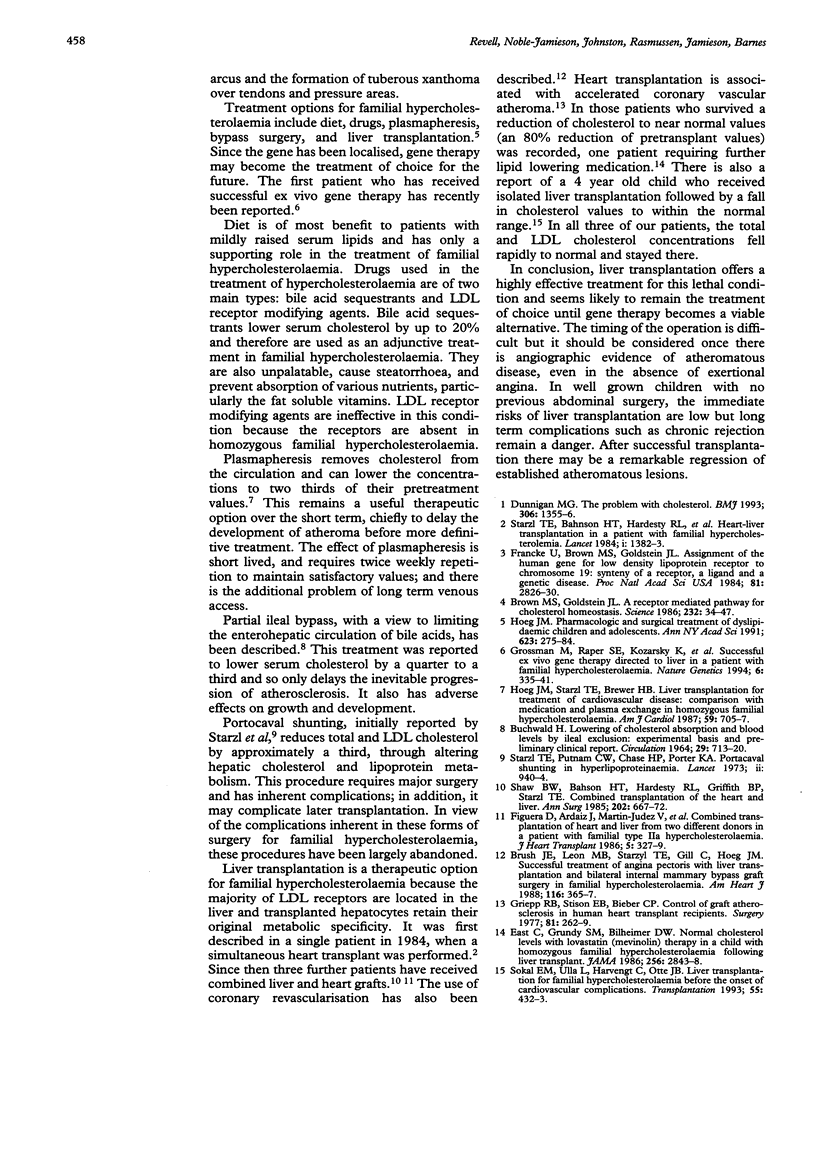Abstract
Homozygous familial hypercholesterolaemia is a rare inherited condition with an incidence of approximately one in a million. It is associated with severe premature atherosclerosis and early death from cardiovascular complications. The results of liver transplantation reported to date have suggested only partially effective reduction of the hypercholesterolaemia. Three boys with familial hypercholesterolaemia, aged 10.0 to 15.1 years, received liver grafts at Addenbrooke's Hospital. Their untreated fasting lipid concentrations were grossly raised. All three had angiographic evidence of coronary atheroma and two had exertional angina. One child had such severe atheroma that coronary artery bypass surgery was considered necessary before liver transplantation. All three had straightforward operative and postoperative courses and their lipid concentrations returned rapidly to normal. One boy developed chronic rejection requiring retransplantation. Currently all three boys are well, on normal diets, and with normal liver function. It is concluded that (1) liver transplantation offers highly effective treatment for this lethal condition, (2) timing the operation is difficult but it should be undertaken before coronary artery disease has progressed too far (when combined liver and heart transplantation may be the only possibility), and (3) in well grown children with no previous abdominal surgery the immediate risks of liver transplantation are low but chronic rejection remains a danger.
Full text
PDF


Selected References
These references are in PubMed. This may not be the complete list of references from this article.
- BUCHWALD H. LOWERING OF CHOLESTEROL ABSORPTION AND BLOOD LEVELS BY ILEAL EXCLUSION. EXPERIMENTAL BASIS AND PRELIMINARY CLINICAL REPORT. Circulation. 1964 May;29:713–720. doi: 10.1161/01.cir.29.5.713. [DOI] [PubMed] [Google Scholar]
- Brown M. S., Goldstein J. L. A receptor-mediated pathway for cholesterol homeostasis. Science. 1986 Apr 4;232(4746):34–47. doi: 10.1126/science.3513311. [DOI] [PubMed] [Google Scholar]
- Dunnigan M. G. The problem with cholesterol. BMJ. 1993 May 22;306(6889):1355–1356. doi: 10.1136/bmj.306.6889.1355. [DOI] [PMC free article] [PubMed] [Google Scholar]
- East C., Grundy S. M., Bilheimer D. W. Normal cholesterol levels with lovastatin (mevinolin) therapy in a child with homozygous familial hypercholesterolemia following liver transplantation. JAMA. 1986 Nov 28;256(20):2843–2848. [PubMed] [Google Scholar]
- Figuera D., Ardaiz J., Martín-Júdez V., Pulpón L. A., Pradas G., Cuervas-Mons V., Burgos R., Arcas M., Pardo F., Cienfuegos J. A. Combined transplantation of heart and liver from two different donors in a patient with familial type IIa hypercholesterolemia. J Heart Transplant. 1986 Jul-Aug;5(4):327–329. [PubMed] [Google Scholar]
- Francke U., Brown M. S., Goldstein J. L. Assignment of the human gene for the low density lipoprotein receptor to chromosome 19: synteny of a receptor, a ligand, and a genetic disease. Proc Natl Acad Sci U S A. 1984 May;81(9):2826–2830. doi: 10.1073/pnas.81.9.2826. [DOI] [PMC free article] [PubMed] [Google Scholar]
- Griepp R. B., Stinson E. B., Bieber C. P., Reitz B. A., Copeland J. G., Oyer P. E., Shumway N. E. Control of graft arteriosclerosis in human heart transplant recipients. Surgery. 1977 Mar;81(3):262–269. [PubMed] [Google Scholar]
- Grossman M., Raper S. E., Kozarsky K., Stein E. A., Engelhardt J. F., Muller D., Lupien P. J., Wilson J. M. Successful ex vivo gene therapy directed to liver in a patient with familial hypercholesterolaemia. Nat Genet. 1994 Apr;6(4):335–341. doi: 10.1038/ng0494-335. [DOI] [PubMed] [Google Scholar]
- Hoeg J. M. Pharmacologic and surgical treatment of dyslipidemic children and adolescents. Ann N Y Acad Sci. 1991;623:275–284. doi: 10.1111/j.1749-6632.1991.tb43737.x. [DOI] [PubMed] [Google Scholar]
- Hoeg J. M., Starzl T. E., Brewer H. B., Jr Liver transplantation for treatment of cardiovascular disease: comparison with medication and plasma exchange in homozygous familial hypercholesterolemia. Am J Cardiol. 1987 Mar 1;59(6):705–707. doi: 10.1016/0002-9149(87)91199-4. [DOI] [PMC free article] [PubMed] [Google Scholar]
- Shaw B. W., Jr, Bahnson H. T., Hardesty R. L., Griffith B. P., Starzl T. E. Combined transplantation of the heart and liver. Ann Surg. 1985 Dec;202(6):667–672. doi: 10.1097/00000658-198512000-00001. [DOI] [PMC free article] [PubMed] [Google Scholar]
- Sokal E. M., Ulla L., Harvengt C., Otte J. B. Liver transplantation for familial hypercholesterolemia before the onset of cardiovascular complications. Transplantation. 1993 Feb;55(2):432–433. doi: 10.1097/00007890-199302000-00037. [DOI] [PubMed] [Google Scholar]
- Starzl T. E., Bilheimer D. W., Bahnson H. T., Shaw B. W., Jr, Hardesty R. L., Griffith B. P., Iwatsuki S., Zitelli B. J., Gartner J. C., Jr, Malatack J. J. Heart-liver transplantation in a patient with familial hypercholesterolaemia. Lancet. 1984 Jun 23;1(8391):1382–1383. doi: 10.1016/s0140-6736(84)91876-2. [DOI] [PMC free article] [PubMed] [Google Scholar]
- Starzl T. E., Putnam C. W., Chase H. P., Porter K. A. Portacaval shunt in hyperlipoproteinaemia. Lancet. 1973 Oct 27;2(7835):940–944. doi: 10.1016/s0140-6736(73)92599-3. [DOI] [PubMed] [Google Scholar]


